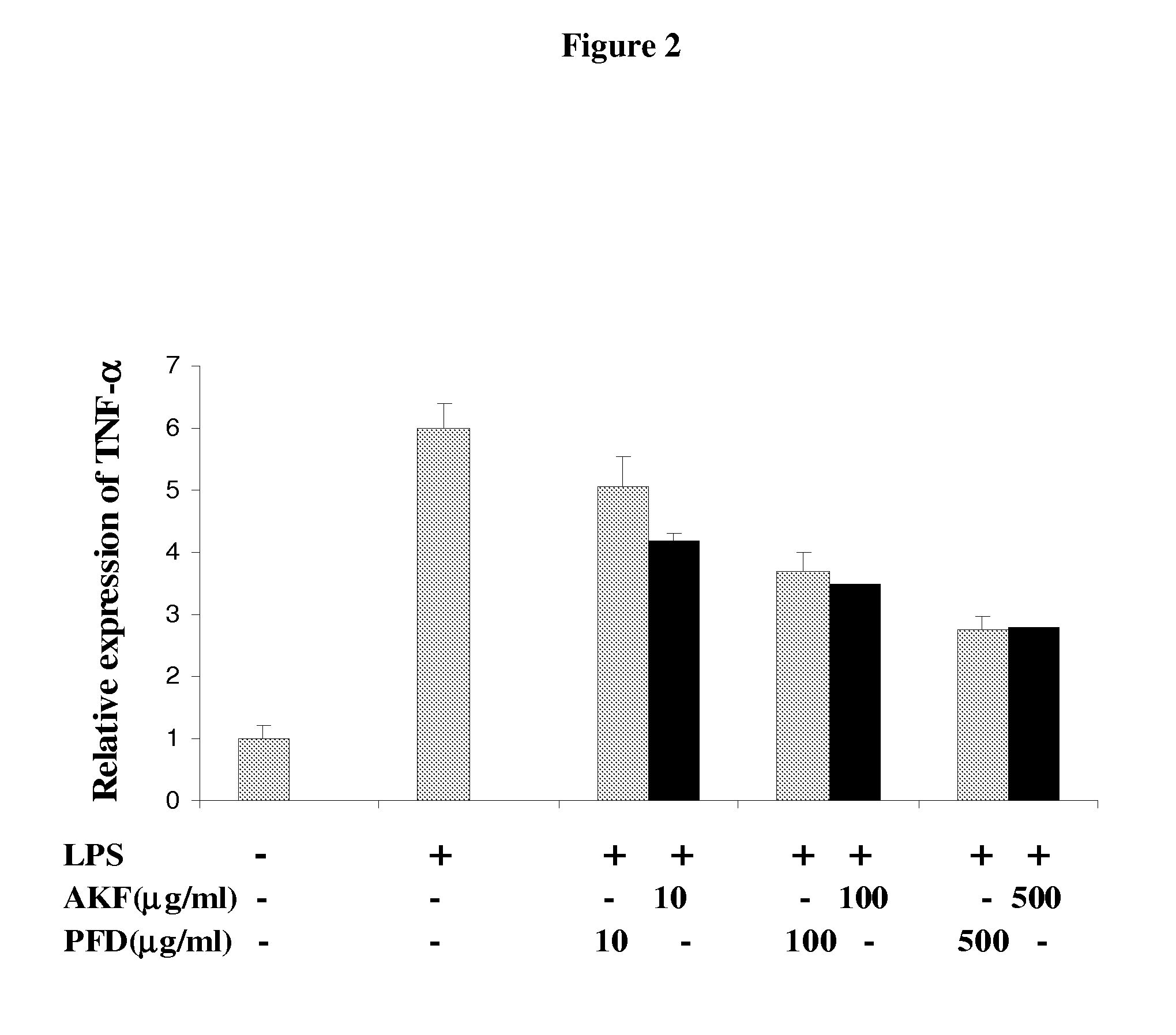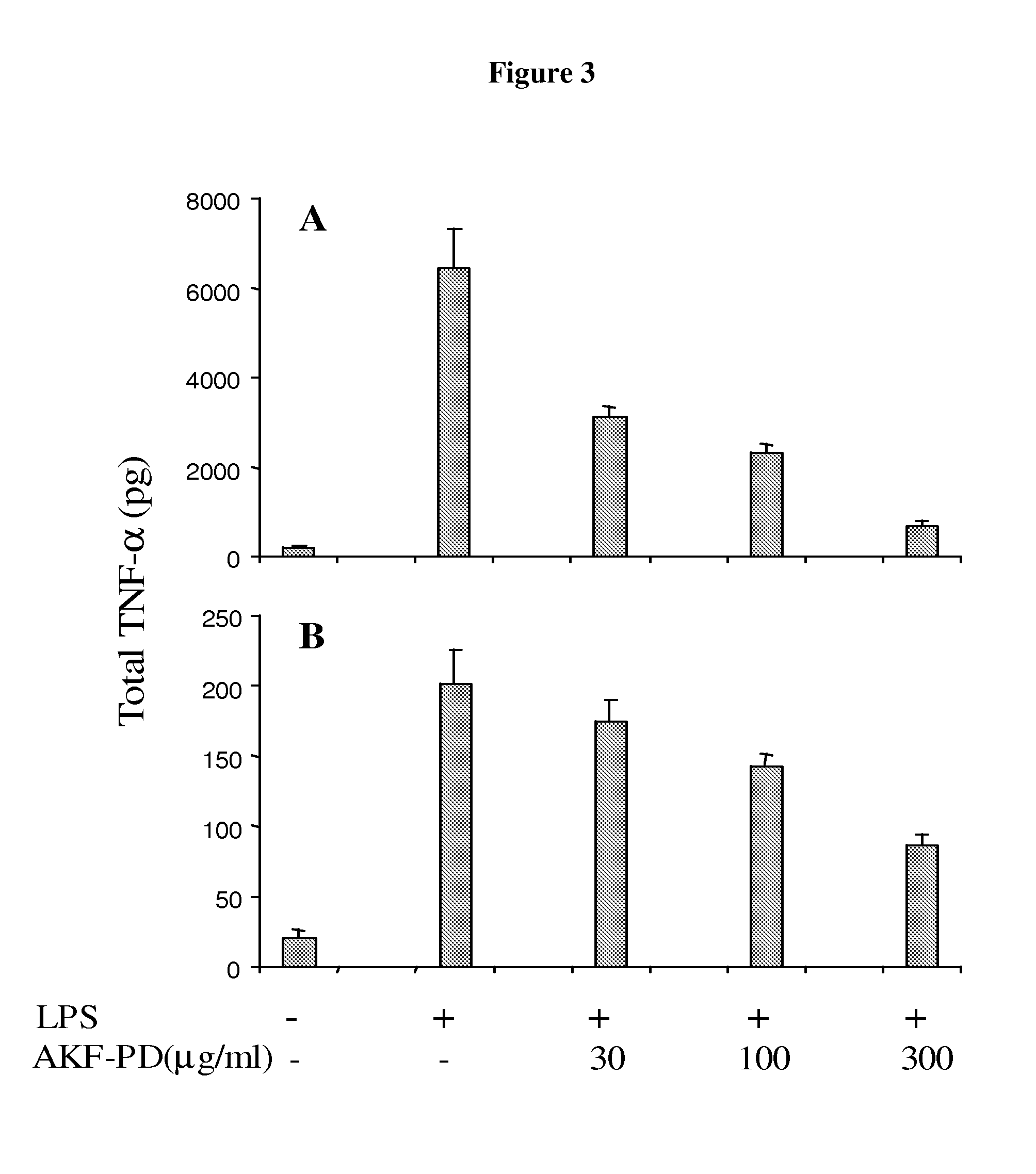Composition and method for treating proteinuria
a proteinuria and composition technology, applied in the field of proteinuria composition and method, can solve the problems of diabetes, ckd and kidney failure, and the development of diabetic kidney disease takes many years, and achieve the effect of reducing proteinuria
- Summary
- Abstract
- Description
- Claims
- Application Information
AI Technical Summary
Benefits of technology
Problems solved by technology
Method used
Image
Examples
example 1
Inhibition of p38 MAPK Activation by AKF-PD
[0048]The MAPK family of proteins comprises of three-tiered cascades of Erk1 / 2, p38, and JNK. The p38 kinase is activated by phosphorylation of a conserved Thr-Gly-Tyr motif in the activation loop. The activated p38 is then able to phosphorylate a wide variety of targets in the cytoplasm and nucleus, resulting in cellular responses such as apoptosis, inflammation, and fibrosis. We first analyzed the anti-inflammatory properties of AKF-PD in p38 signaling in lipopolysaccharide (LPS)-stimulated mouse macrophages RAW264.7 cells. Cells are pre-treated with AKF-PD or pirfenidone (PFD) for 4 hours and then stimulated by treatment with LPS. As shown in FIG. 1, treatment of the cells with LPS resulted in a robotic stimulation of p38 activation. Both AKF-PD (FIG. 1A) and PFD (FIG. 1B) significantly blocked LPS-induced p38 activation. No effects on total p38 protein levels were observed showing that AKF-PD and PFD have no effect on protein stability....
example 2
Inhibition of TNF-α mRNA Synthesis in Mouse Macrophage by AKF-PD and PFD
[0049]Macrophages are an important source of TNF-α and other pro-inflammatory cytokines during RA and a number of pathways including p38 MAPK have been suggested to contribute to the LPS-induced TNF-α production in this cell type. We next investigated the effect of AKF-PD on TNF-α transcription. Treatment of the cells with LPS significantly increased mRNA level of TNF-α up to 6-fold; both AKF-PD and PFD possessed a dose-dependent inhibition on LPS-stimulated TNF-α mRNA synthesis (FIG. 2). Approximately 50% inhibition was reached at the dose of 500 μg / ml.
example 3
Inhibition of TNF-α Protein Synthesis and Secretion in Macrophage by AKF-PD
[0050]The effect of AKF-PD on TNF-α protein synthesis and secretion was analyzed in LPS-stimulated RAW264.7 cells. Cells were pretreated with AKF-PD and then stimulated by LPS. Both secreted and cellular levels of TNF-α protein were determined. Consistent with the inhibitor effect on mRNA levels, pretreatment of the cells with AKF-PD induced a dose-dependent inhibition on TNF-α protein levels (FIG. 3). AKF-PD, at the dose of 100 μg / ml, caused a 64% inhibition of secreted levels of TNF-α. At the dose of 300 μg / ml, AKF-PD achieved a robust 89% inhibition of secreted levels of TNF-α (FIG. 3A). AKF-PD also suppressed the cellular levels of TNF-α but with less inhibitory effect, achieving approximately 50% inhibition at dose of 300 μg / ml (FIG. 3B). Therefore, the exposure of RAW264.7 cells to AKF-PD exerted a significant and dose-dependent suppression of levels of both cell-associated and secreted TNF-α protein.
PUM
| Property | Measurement | Unit |
|---|---|---|
| compositions | aaaaa | aaaaa |
| blood pressure | aaaaa | aaaaa |
| interstitial | aaaaa | aaaaa |
Abstract
Description
Claims
Application Information
 Login to View More
Login to View More - R&D
- Intellectual Property
- Life Sciences
- Materials
- Tech Scout
- Unparalleled Data Quality
- Higher Quality Content
- 60% Fewer Hallucinations
Browse by: Latest US Patents, China's latest patents, Technical Efficacy Thesaurus, Application Domain, Technology Topic, Popular Technical Reports.
© 2025 PatSnap. All rights reserved.Legal|Privacy policy|Modern Slavery Act Transparency Statement|Sitemap|About US| Contact US: help@patsnap.com



